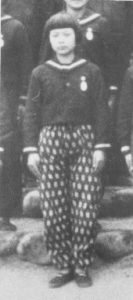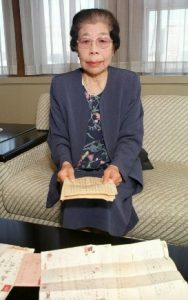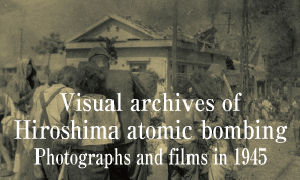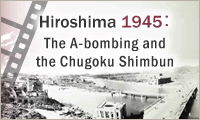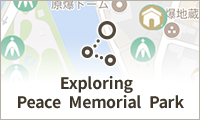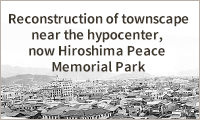Hiroshima Municipal Girls’ School former student sincerely hopes two letters from friend killed in A-bombing are returned to family, after learning of death in Chugoku Shimbun
Mar. 19, 1999
On March 9, Yasuko Aso (née Mikami), 67, a resident of Takasu 2-chome in Hiroshima City’s Nishi Ward, gave the Chugoku Shimbun letters she had received four months before the atomic bombing from a former classmate at Hiroshima First Municipal Girls’ School (Municipal Girls’ School; present-day Funairi High School) who had died in the bombing. Ms. Aso learned of the death of her classmate through one of the newspaper’s feature articles titled “Photographs of the Dead Speak: Second-year students at Hiroshima First Municipal Girls’ School,” published on February 28, 1999. “I wanted to give the letters back to her surviving family as a keepsake,” said Ms. Aso, who hopes for the return of the letters she has held on to for more than half a century.
The letters were written by “Taeko Furukawa,” a second-year student at Municipal Girls’ School at the time of the atomic bombing. The two letters, dated March 31 and April 6, 1945, remain today.
“On April 5, little first-year students started attending the school … On April 9, we were no longer allowed to wear shoes indoors. We also have to attend morning assembly in bare feet. Everyone says, ‘My feet are so cold’,” wrote Ms. Furukawa. In the letters, she described details of school events and about other classmates to Ms. Aso, who had transferred from Municipal Girls’ School to Yamaguchi Prefectural Girls’ School in Yamaguchi City in the summer of her first year at school because of her father’s job transfer. When they were first-year students, the two girls had been in the same Class 4 at Municipal Girls’ School.
On August 6, a total of 541 second-year students including Ms. Furukawa and first-year students at the school were killed in the atomic bombing while being mobilized to help in the work of building demolition for the creation of fire lanes in the area to the south of present-day Peace Memorial Park, located in Hiroshima’s Naka Ward. Five years after the bombing, Ms. Aso returned to Hiroshima. She was hesitant to ask about the fate of her former classmates at school with whom she had such a short relationship. “If I had not transferred to the other school, I would have suffered the same fate,” she thought to herself. She carefully held on to the letters in remembrance of her dead classmate.
Ms. Aso said she learned of the specific deaths of Ms. Furukawa and other former classmates at school for the first time through the article series “Photographs of the Dead Speak.” Ms. Aso found in the newspaper that she herself had been included in one of the class photos that remained of the school’s six classes of 226 second-year students taken at the time they first entered the school.
It was then that Ms. Aso came up with the idea of returning the letters from her friend that she had been keeping to Ms. Furukawa’s surviving family. She said, “Former students still alive are working together to keep a record of the deceased classmates. I also want to contribute what I can.” Ms. Furukawa’s address at that time written on the back of the envelopes indicates “1-1, Enomachi, Hiroshima City.” According to a record from the association of bereaved families of the Municipal Girls’ School, the name of her surviving family member is “Emiko, older sister.”
In addition, photos of five students have been newly identified as deceased “second-year students at the Hiroshima Municipal Girls’ School” by surviving family members and acquaintances who had read the feature article of the Chugoku Shimbun published on February 28, 1999. And four of 11 former second-year students whose fate after the atomic bombing had been unknown have directly reached out to the paper.
(Originally published on March 10, 1999)
The letters were written by “Taeko Furukawa,” a second-year student at Municipal Girls’ School at the time of the atomic bombing. The two letters, dated March 31 and April 6, 1945, remain today.
“On April 5, little first-year students started attending the school … On April 9, we were no longer allowed to wear shoes indoors. We also have to attend morning assembly in bare feet. Everyone says, ‘My feet are so cold’,” wrote Ms. Furukawa. In the letters, she described details of school events and about other classmates to Ms. Aso, who had transferred from Municipal Girls’ School to Yamaguchi Prefectural Girls’ School in Yamaguchi City in the summer of her first year at school because of her father’s job transfer. When they were first-year students, the two girls had been in the same Class 4 at Municipal Girls’ School.
On August 6, a total of 541 second-year students including Ms. Furukawa and first-year students at the school were killed in the atomic bombing while being mobilized to help in the work of building demolition for the creation of fire lanes in the area to the south of present-day Peace Memorial Park, located in Hiroshima’s Naka Ward. Five years after the bombing, Ms. Aso returned to Hiroshima. She was hesitant to ask about the fate of her former classmates at school with whom she had such a short relationship. “If I had not transferred to the other school, I would have suffered the same fate,” she thought to herself. She carefully held on to the letters in remembrance of her dead classmate.
Ms. Aso said she learned of the specific deaths of Ms. Furukawa and other former classmates at school for the first time through the article series “Photographs of the Dead Speak.” Ms. Aso found in the newspaper that she herself had been included in one of the class photos that remained of the school’s six classes of 226 second-year students taken at the time they first entered the school.
It was then that Ms. Aso came up with the idea of returning the letters from her friend that she had been keeping to Ms. Furukawa’s surviving family. She said, “Former students still alive are working together to keep a record of the deceased classmates. I also want to contribute what I can.” Ms. Furukawa’s address at that time written on the back of the envelopes indicates “1-1, Enomachi, Hiroshima City.” According to a record from the association of bereaved families of the Municipal Girls’ School, the name of her surviving family member is “Emiko, older sister.”
In addition, photos of five students have been newly identified as deceased “second-year students at the Hiroshima Municipal Girls’ School” by surviving family members and acquaintances who had read the feature article of the Chugoku Shimbun published on February 28, 1999. And four of 11 former second-year students whose fate after the atomic bombing had been unknown have directly reached out to the paper.
(Originally published on March 10, 1999)

